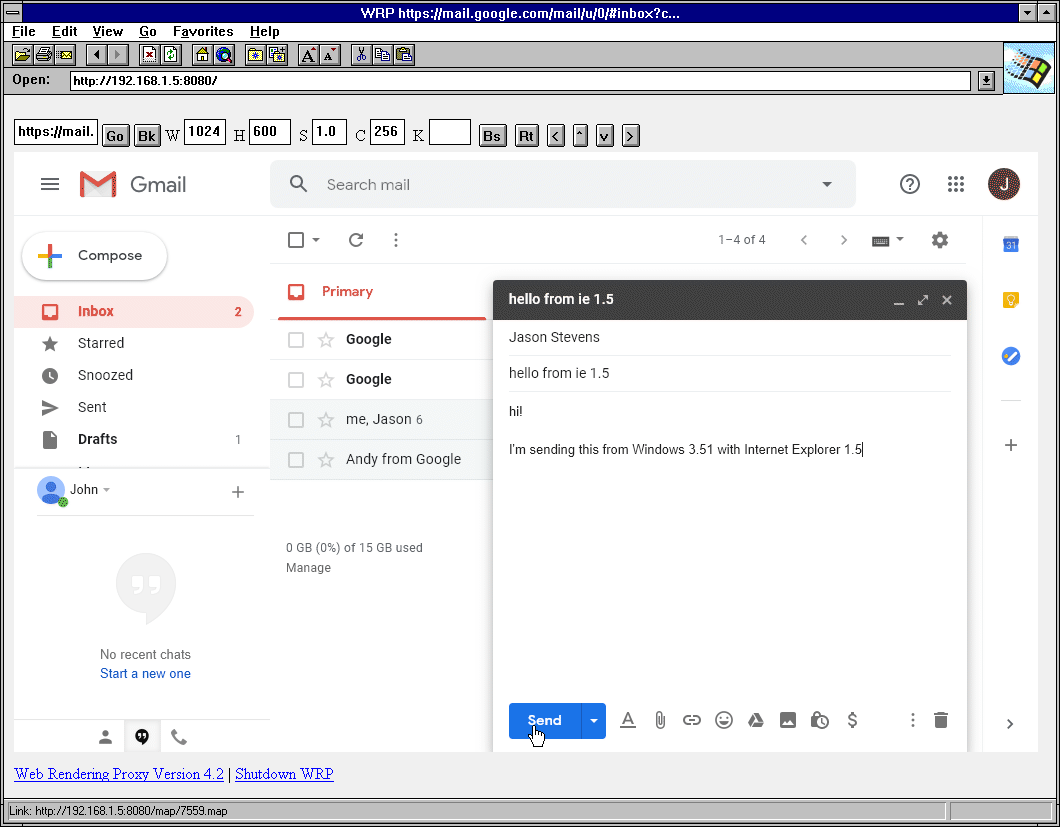mirror of
https://github.com/tenox7/wrp.git
synced 2025-02-09 06:30:32 +00:00
WRP - Web Rendering Proxy
A HTTP proxy server that allows to use historical / vintage web browsers on the modern web. It works by rendering a web page in to GIF image with ISMAP.
Current Status
- This is a new version using GoLang/ChromeDP (Python/Webkit is now deprecated).
- Fully supported an maintained.
- Works as browser-in-browser. A real http proxy mode is being investigated. Check issue #35 for updates.
- Supports clicking on non-link elements (eg. cookie warnings, dropdown menus, etc.) and sending keystrokes. Yes, you can login to Gmail.
Usage
- Download a WRP binary and run it on a machine that will become your WRP gateway server.
- Point your legacy browser to
http://address:portof WRP server. Do not set or use it as a "Proxy Server" (yet). - Type a search string or a http/https URL and click Go.
- Adjust your screen width/height/scale/#colors to fit in your old browser.
- Scroll web page by clicking on the in-image scroll bar.
- Do not use client browser history-back, instead use Bk WRP button.
- To send keystrokes fill K input box and press Go. There also are buttons for backspace, enter and arrow keys.
Docker
docker run -d -p 8080:8080 tenox7/wrp
Flags
-l listen address:port, default :8080
-h headed mode, display browser window
-d chromedp debug logging
Minimal Requirements
-
Server / Gateway should run on a modern hardware/os that supports memory hungry Chrome.
-
Client / Browser needs to support HTML FORMs and ISMAP. Typically Mosaic 2.0 would be minimum version for forms. However ISMAP was supported since 0.6B, so if you manually enter url using
?url=...you can use ealier version.
History
- In 2014, version 1.0 started as a cgi-bin script, adaptation of
webkit2png.pyandpcidade.py, blog post. - Later in 2014, version 2.0 became a stand alone http-proxy server, also support for both Linux/MacOS, another post.
- In 2016 the whole internet migrated to HTTPS/SSL/TLS and WRP largely stopped working. Python code became unmaintainable and mostly unportable (especially to Windows, even WSL).
- In 2019 WRP 3.0 has been rewritten in Golang/Chromedp as browser-in-browser instead of http proxy.
- Later in 2019, WRP 4.0 has been completely refactored to use mouse clicks instead using a href nodes. Also in 4.1 added sending keystrokes in to input boxes. You can now login to Gmail. Also now runs as a Docker container.
Credits
- Uses chromedp, thanks to mvdan for dealing with my issues
- Uses go-quantize, thanks to ericpauley for developing the missing go quantizer
- Thanks to Jason Stevens of Fun With Virtualization for graciously hosting my rumblings
- Thanks to claunia for help with the Python/Webkit version in the past
Legal Stuff
License: Apache 2.0
Copyright (c) 2013-2018 Antoni Sawicki
Copyright (c) 2019 Google LLC
Description
Web Rendering Proxy: Use vintage, historical, legacy browsers on modern web
browserchromechrome-devtoolsheadless-chromeimagemaplegacy-browsersproxyrenderingvintage-computerswebwww
Readme
Apache-2.0
1.6 MiB
Languages
Go
82%
HTML
13.8%
Makefile
2.9%
Dockerfile
1.3%
